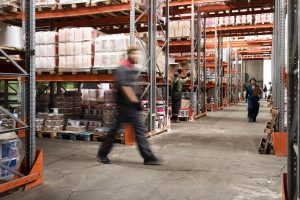The holiday shopping season is a whirlwind of excitement, anticipation, and—let’s be honest—logistical nightmares.
Retailers are put through unprecedented order volumes, expedited delivery times in high demand, and the ever-present pressure for seamless customer experiences. Being able to meet these challenges requires both agility and innovation and more often than not, that means embracing flexible automation within order fulfillment operations.
This year, businesses face unprecedented challenges in meeting peak season demands. Conventional fulfillment processes often falter under fluctuating consumer needs and varied product assortments. Fortunately, adaptable robotic solutions, intelligent warehouse oversight systems, and flexible fulfillment approaches allow companies to manage heightened volumes more efficiently, accurately, and on a larger scale.
The following article will discuss how flexible automation is changing order fulfillment this holiday season.
What is Flexible Automation?
Flexible automation involves adaptable automated systems meant to swiftly adjust to varied production needs. Unlike fixed-automation systems, geared toward exclusive tasks or items, flexible automation can be reprogrammed and rearranged to tackle multiple tasks. This enables manufacturers to produce differing parts or goods with minimal pauses or equipment alterations, boosting flexibility and efficiency within dynamic manufacturing settings.
How flexible automation works:
- Computer input: Control of the system is conducted via a computer that can be programmed for diverse operations.
- Flexibility: Flexibility allows for adjustments in manufacturing other items or adjusting capacity output.
- Human-machine interface: Human-computer interaction is facilitated through an intuitive interface enabling operational control for users. Retaining the human-in-loop channel improves flexibility and agility.
- Integration: Integration capability permits linking with additional systems, like material management and stock control setups.
Why is Flexible Automation in Focus During the Holiday Season?
Surge in Online Shopping and Increased Order Volumes
During the holiday season, online shopping experiences heightened activity, resulting in a surge in order volumes. Flexible automation systems respond swiftly to handle the influx, maintaining smooth operations even as order quantities increase dramatically without needing extensive configurations.
Need for Faster Order Fulfillment
The need for prompt order fulfillment is paramount during holidays, with quick delivery expectations from consumers met through the streamlining of processes like order picking, sorting, and packing facilitated by flexible automation. This leads to faster overall fulfillment, ensuring accuracy amidst the rush.
Unpredictable Demand Patterns
Holidays introduce unpredictable demand patterns, with peaks in demand for particular items making precise forecasting challenging. Flexible automation systems adapt by dynamically shifting between tasks or handling different products, keeping production and fulfillment operations agile and responsive to fluctuating customer demands.
What Are the Unique Needs of Retailers During the Holiday Season?
Seasonal Demand Spikes and the Need for Quick Turnaround
During holiday seasons, retailers encounter substantial spikes in demand, intensifying pressure on them to expedite order fulfillment. Quick inventory management, order processing, and shipping are indispensable as they work to satisfy heightened needs without compromising efficiency or precision.
Diverse Product Offerings Requiring Flexible Systems to Handle Variations
Retailers often diversify their product offerings, necessitating flexible systems to cope with differing requirements, sizes, and shipping needs. Flexible automation solutions are crucial for managing these variations effectively. For example, a retailer may need to quickly switch between packing bulky items like electronics and smaller items like clothing, requiring adaptable systems to manage both efficiently.
Customer Expectations for Fast Shipping and Reliable Service
Throughout the holiday rush, customers expect speedy delivery and reliable shopping. Providers must guarantee punctual shipments, error-free orders, and accessible customer care. Achieving these targets necessitates highly efficient fulfillment strategies merged with adaptable systems capable of handling a large order volume, all while reducing mistakes.
What Are the Benefits of Effective Flexible Automation?
Enhanced Operational Efficiency and Reduced Lead Times
When using flexible automation, production and fulfillment processes are unraveled. In such ways, companies can operate more effectively since the automation of repetitive tasks, and flow optimization reduce lead times. This will ensure that the delivery time for products is quicker, hence improving general operational performance.
Improved Accuracy in Order Processing, Reducing Errors and Returns
With flexible automation in place, the chances of human error in order processing become minimal. Automated systems can pick up orders with great accuracy, pack, and ship them with reduced chances of error that would lead to return cases or dissatisfaction by customers, hence guaranteeing a smooth transition from order to delivery.
Greater Flexibility in Adapting to Changing Demand Patterns
Flexible automation enables businesses to respond quickly to changes in demand. It may be seasonal or a sudden change in consumer preference; the automated systems can reconfigure rapidly to accommodate the new tasks or products at hand, hence enabling firms to become agile and responsive to changes in the market.
What Are the Challenges in Implementing Flexible Automation?
Initial Investment Costs and Budgeting for Technology Upgrades
The leading challenges in implementing flexible automation involve high initial investment costs for the technology, including buying hardware, software, and infrastructure. In this regard, businesses will have to budget cautiously and plan for ongoing maintenance and upgrades, which can add to the financial burden.
Integration With Existing Systems and Workflows
Integration can be complex, as many companies have a number of legacy systems. Sometimes, these are not so easily aligned with the newer solutions brought about by automation. Careful planning will be necessary to ensure smooth integration with minimal disruption of current operations; this may involve custom development or adjustments to the existing processes.
Staff Training and Change Management to Adapt to New Processes
The major problems with flexible automation are the training for the use of new systems and the adjustment of personnel to the changed workflows. As in any change, a proper change management strategy is necessary to make workers aware of how the automation technology works and is kept in good working order—a quantum leap unless the resistance to or lack of competencies in the workforce is high enough.
Conclusion
Retailers tackling the holiday season’s challenges benefit from flexible automation, offering robust solutions for managing escalated demand, streamlining order fulfillment, and enhancing operational efficiency. This strategy ensures agility, satisfies customer needs, and maintains a competitive edge.
Is your warehouse ready to handle the holiday rush? Introducing Carte+, a flexible automation solution that can easily integrate with your processes, aiding in handling unpredictable demand and improving efficiency. Scalable and easy to retrofit, Carte+ empowers your warehouse with the tools needed to navigate seasonal peaks effortlessly.
With Carte+, you can:
- Scale operations to meet surges in holiday demand
- Improve order processing speed and accuracy
- Adapt swiftly to fluctuating product variations and customer needs
Climb to an impressively efficient holiday season by leveraging Carte+. Contact us today and explore how Carte+ can revolutionize your fulfillment strategy through flexible automation, keeping your operations agile and customer satisfaction soaring.





